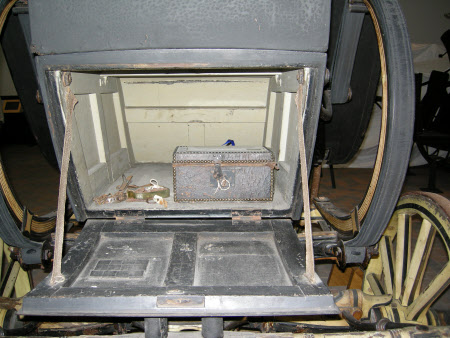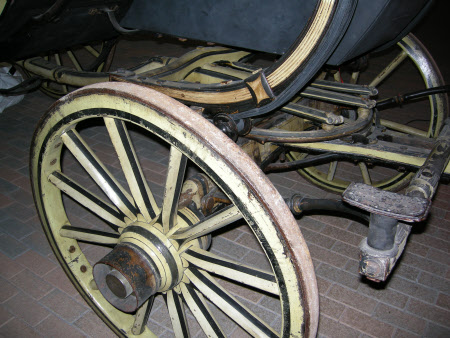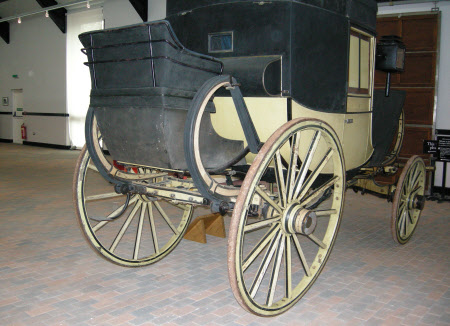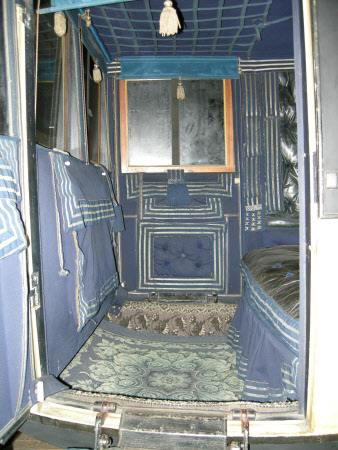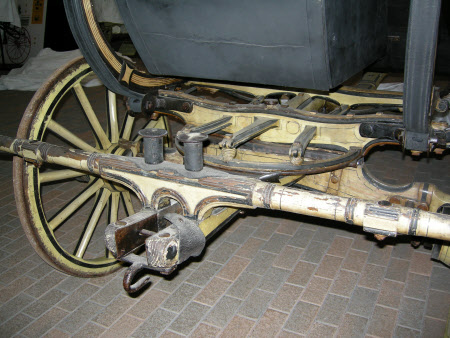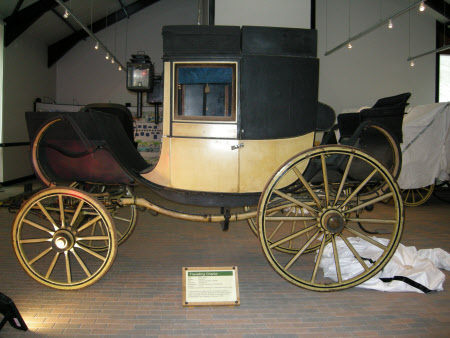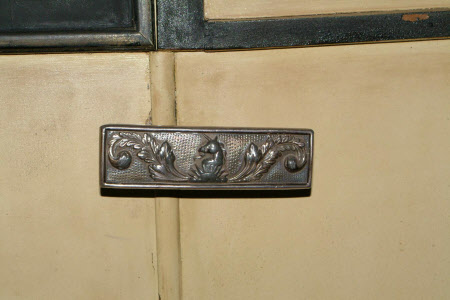Travelling chariot
Clover
Category
Carriages & other vehicles
Date
circa 1815
Materials
Painted wood body with roof imperials, leather and wool cloth upholstery and four iron shod wheels.
Measurements
222 x 411.5 x 183.5cm (7ft 3 1/2in x 13ft 6in x 6ft 1/4in)
Order this imageCollection
National Trust Carriage Museum
NT 272895.1
Caption
One of the oldest, and most important, carriages in the collection; Gibbs Crawfurd Antrobus used this travelling chariot when he attended the Congress of Vienna (1814-15). It has its original imperials (light wooden ‘suitcases’ covered in leather) carried on the roof and, in this case, also on the front boot. There is also a sword case at the back of the body to carry the dress sword.
Summary
Travelling Chariot built for Colonel Antrobus by Clover circa 1815. Travelling Chariot (four wheels) for a pair or team of horses. This chariot is on C springs and compassed perch with platform boot and boot imperial in front. There is a hind footboard and a hind boot incorporating a rumble seat behind. The body has a sword case to back . There are two roof imperials. The interior is of black leather and dark and light blue upholstery. Painted in yellow and black livery with heraldry crest on two sides - 'Dei Memor Gratus Amicus' Mindful of God, Grateful to Friends.
Full description
This carriage dates from the early 1800's and was donated by Colonel Antrobus. It is believed that his ancestor Gibbs Crawfurd Antrobus used this travelling chariot in his career as a diplomat which took him through Europe at a time of political change. As a junior secretary under Lord Castlereagh he attended the Congress of Vienna (1814-15) that marked the end of the Napoleonic War. In 1824 he was created Envoy Extraordinary and Minister Plenipotentiary for George IV to the Kingdom of the Two Sicilies, which was governed from Naples. His official accreditation, signed by the King, with the royal seal attached, was his letter of authority. A silver case mounted with the royal arms protects the seal. As part of his official uniform he wore a dress sword, and there is a sword case at the back of the body in which it would have been carried. The carriage has its original imperials (light wooden cases covered in leather) carried on the roof and, in this case, also on the front boot. On long journeys it would be pulled by pairs or teams of post horses hired at inns along the way, ridden by post boys who would then hack the horses back from the next post. The horses were changed every 10-12 miles. It could seat two passengers inside and two servants in the rumble seat on the hind boot. It would be postillion-driven for travelling and, by fitting a coachman’s seat; it could be converted for town use, when a coachman would have driven it.
Provenance
This carriage went ot Vienna in 1812.
Marks and inscriptions
On offside side panel. : Heraldry crest - 'Dei Memor Gratus Amicus' Mindful of God, Grateful to Friends. On nearside side panel.: Heraldry crest - 'Dei Memor Gratus Amicus' Mindful of God, Grateful to Friends. On locking bolt to the futchells.: B. CLOVER On the flange of the nearside front axle cap.: 1846 On the flange of the offside front axle cap.: 1846 On the flange of the nearside rear axle cap.: 1846 On the flange of the offside rear axle cap.: 1846 On the front nearside axle arm.: BASSONO & FISHER - ALBION WORKS, BIRMINGHAM On the front offside axle arm.: BASSONO & FISHER - ALBION WORKS, BIRMINGHAM On the rear nearside axle arm.: BASSONO & FISHER - ALBION WORKS, BIRMINGHAM On the rear offside axle arm.: BASSONO & FISHER - ALBION WORKS, BIRMINGHAM On a plate on the inside of the base of the nearside lamp.: MANUFACTURED BY B.BLACK PATENTEE SOUTHAMPTON ST GROSVENOR SQR LONDON On a plate on the inside of the base of the offside lamp.: MANUFACTURED BY B.BLACK PATENTEE SOUTHAMPTON ST GROSVENOR SQR LONDON
Makers and roles
Clover, coach builder

